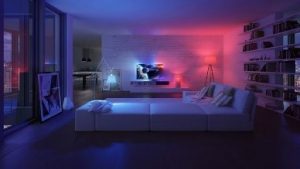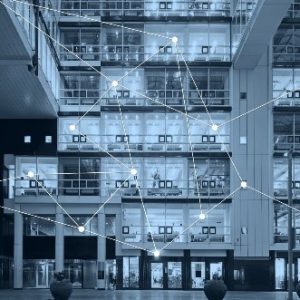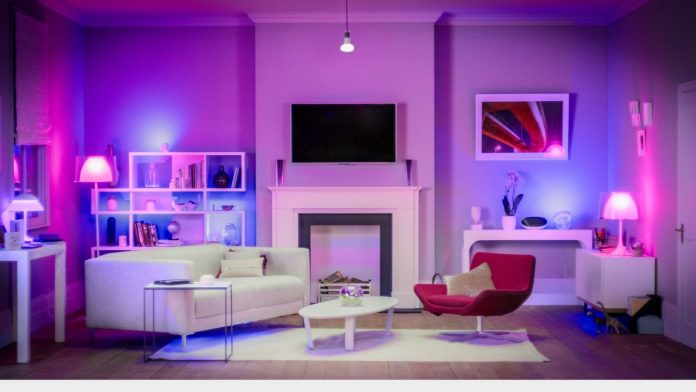Lighting for smart buildings
This is a smart generation surrounded by smart gadgets that helps with intelligent solutions and ease to the users. These smart solution has transformed our lives with leaps and bounds and this has happened because of the major advancement in IoT (internet of things) and AI (artificial intelligence). We may not acknowledge this, but IoT and AI are everywhere. More or less, it has become an omnipresent thing next to god.
Physical objects have now become an ecosystem of information shared between devices that are wearable, portable, and even implantable, making our lives technology and data enriched. Virtually in every industry, the machines have also gone to the next level. Now it’s more like they have their own brains, in terms of one just has to let the machine know what to be done and how and it will be at the user’s beck and call. This has enabled the industry in reaching its desired production goals smoothly.
Smart lighting generally uses mesh networking, where each smart bulb wirelessly connects to its closest neighbor. That network is controlled by a hub that plugs into your router, enabling your other networked devices – such as your phone or tablet – to communicate with your bulbs.
IoT based Smart Street Lighting
Smart street lighting, where lights can turn on and off according and adjusting to the surrounding lighting conditions. Not only that, but the intensity of the light increases as soon as anyone passes through from a particular lamp and vice-versa. 
In case of some emergency or any accident, the lamps increase lights to the maximum level therefore the safety of the people would be enhanced. Any type of breakdown in the street lights would be immediately reported to the cloud or to the service center and it can be resolved remotely. The rage for remote assistance to the breakdown in the lighting system can be sent up to a distance of 50 km.
To understand the working of this magical lighting system, we would have to dive a little deeper into its functionality. There is a power source connected to a LED chip and a control unit. The control center will be monitoring and controlling all the street lights and sends data to its cloud and maintains the street lighting system.
Smart street lighting is an intelligent street lighting control system that uses AI (Artificial intelligence) to deliver automated services. Street lighting is a community service and consumes a major portion of energy resources. The rise in demand for power and significant gap in demand and supply issues such as power outages and unoptimized usage like bright street lights in low footfall areas lead to substantial wastage.
The components of smart street lighting are Light Dependent Resistors (LDR) input, IR (Infrared) sensor, LED, and UART (Universal asynchronous Receiver/ Transmitter). In the smart street lighting system, the street lights will automatically be turned on and off. The traditional HID lamps that consume a massive amount of energy are now being replaced with LED diodes, as they are supremely energy-efficient and have a higher magnitude of effectiveness when coupled with LDR which enables the intensity variation of light.
Lighting for smart homes
Imagine getting rid of the mental and physical exhaustion to set up the lighting for a party hosted in your home. Well, no stop right there, you don’t need to imagine that because it is now possible in the real world and with as much effort as you need to put for doing a snap. Not for just a party, but for your every mood there is a lighting solution out there. Switching out a light bulb requires so little time and effort, but can make a huge difference in how you interact with your home. Potentially, switching to smart bulbs is the easiest way and first step towards upgrading your home into a smart home. You can trade off the existing CFL or LED bulbs in your lamps and lighting fixtures with a Philips Hue, Lifx Mini, Eufy Lumos LED, or many other models. These smart bulbs will surrender their control to you and your fingers with your phone or through Alexa or Google Assistant. Moreover, you can program them to turn on at any time and dim them at will, even if you don’t have a dimmer switch.
Majorly, smart bulbs come in two categories of colors; white only and color. However, if you are willing to walk an extra mile that won’t create a deep hole in your pocket you can go for color bulbs as well, as they come with color options. This means that you can select any color from the rainbow according to your mood, however, these bulbs cost a bit more than the regular color bulbs. This allows you to have a lot of fun with your lights. Many models have light preferences that can replicate sunrise or sunset, and lets you change the light from an energizing blue to a calm warm orange.
Beyond that, you can program your lights (often with the help of IFTTT, Alexa, or Google Assistant) to change colors when your alarms go off or you get a new email. You can also make them slowly fade to darkness as you fall asleep or slowly illuminate at sunrise.
With countless shades of vivid, brightly-colored light available with just a voice command or a few taps on your phone, lights like those certainly can make for a more modern and striking-looking living space. These kinds of lights have practical uses, too. For instance, coupled with the right automation, they can mimic the way natural light changes throughout the day, or signal you when you have a new email from an important contact. Not only these lights can set as per your preferences but they also assist you to have a visualized alarms. Most of the major brands have their own channel on the free, online automation service IFTTT, hook them up with your Amazon Echo device via the Alexa channel, and you’ll be able to tell them to blink the lights or change their color whenever one of your timers goes off.
Pretty every smart light will give the option to program a recurring light change at a specific time of the day, so scheduling your bedroom lights to come on automatically in the morning is a decent start. You will also be able to change the color shades telling you how much time you have left to snooze. For instance, if you like to wake up at 5.30 in the morning, you set a bedside lamp to start at a slow, 90- minute fade at 4 a.m. The light is red to start but is gradually adjusts to yellow after 30 minutes, and then after an hour to green, which literally means “go, and get your lousy self out of the bed.” There will be no need of squinting at the clock.
Lighting up a Conversation
Smart lighting has opened a new realm of possibilities that have been untapped entirely, earlier. Lighting can have conversations with people now. Take the tallest building Burj khalifa into account. Be it the independence day of India or the 150th birth anniversary of the father the world’s largest democracy; India, Burj Khalifa conveyed their warmest wishes and thoughts to the whole world by displaying it onto the whole building.
Facade lighting technology helps to achieve the mesmerizing results that the whole world witnessed on Burj Khalifa. This lighting technology has set new trends in the industry and of course new records in the world. The primary part of facade lighting technology is the LED bulbs. For the ones that are being used in Burj, it contains RGBW (red, green, blue, white) strips, which gives more options for color and light mixing capabilities. The efficiency in these strips is higher due to the heat disperses from the LED pins out to the PCB copper. The higher the copper area, the higher would the efficiency. Each segment contains each color of the LED which would be connected to its own respective colors; green to green, blue to blue, and red to red. These segments are then further connected to the RGBW strips in a parallel form. Therefore, by connecting each strip with their segment the strips can be long and it can be connected to a long length, usually, at the top or bottom, both the drivers and controllers will be placed. Installing it all together, and you are good to go. The linear LED lighting software is used to set custom lighting.
With over 1.2 million LED lights on the facade, Burj Khalifa has set a new trend in the industry with this technique of smart lighting. In totality, the small strips of LED make the building into a large screen forming a composite image of the photos or videos that are being played on the laptop and creates magic.
Facade Lighting is now being used for hotels, monuments, and in some cases for residential buildings as well. It has become a new way to grab and hold the attention of people passing by. The Beating Retreat ceremony is one big event where the Indian musical tune undulates away the masses attending the event. Not only have the performances, but the picturesque and breathtaking beauty of the lightings on the heritage of Rashtrapati Bhawan also attracts every possible eyeball. Not only the Rashtrapati Bhawan gets decorated in lightning, but India Gate also drapes itself under the scintillating lightings.
This LED fitting has around 1 lakh burning hours whereas earlier light fixtures were around 10,000 burning hours. The new lighting system has computerized control having unified power and data cable for easy installation and maintenance with automation in the selection of color combination scheme using opti-bin technology, selection of timing, facility of dimming, switching on and off facility, individual and combined control of light fittings, etc. through Ethernet-based controller.
This system is energy efficient as well as cost-effective and there is value addition by putting this system on these buildings.
Lighting the Future
All spaces are not created as equal and lighting is one of the key components in any or every space possible, and hence easy access to the light control. Coupling Educational institutions with the technology of smart lighting can help the students to perform more efficiently, as smart lighting techniques would kick the boredom out of the classrooms. Students will not have to look at the same dull and monotonous ceiling of the classroom all day. They can have riveting visual experiences while studying. There can be an ocean or an even galaxy in the classroom, or any other thing as well as per the preferences of the students or faculty.
Not only this, the smart lights will give greater access to the light controls and their intensity as well. Classrooms and other educational facilities need to be well-lit whenever students and faculty are present. Traditional fixtures can be expensive to operate over a long period of time, and in many cases, they are left on when they don’t need to be. They also offer little in the way of flexibility, giving the same amount of illumination no matter what the circumstances.
As lighting needs to be bright to help students focus during classes or softer administrators look for solutions that offer efficiency as well as adaptability, they are turning to smart lighting for schools. These systems not only offer more control over which lights are used and when, but they also deliver a greater degree of customization. Whether for after-hours library study sessions, smart lighting allows users to find the perfect setting.
Rather than operating fixtures individually with switches throughout the building, smartphone apps and other connected devices give users the opportunity to control the entire property from a single place. Much of the energy wasted by large properties results from lights left on when no one needs them. With motion sensors, however, lights can switch themselves off automatically when no one is detected in the room. Many classrooms have large windows that let in a lot of natural daylight. Smart illumination systems can detect this light and adjust the artificial illumination accordingly, ensuring that no unnecessary energy is consumed.
Studies have consistently found that better lighting is critical for educational facilities. Changing, existing fluorescent and incandescent systems with LEDs can enable schools to reap the benefits for learners.
Smart lighting, better patient wellbeing
Smart lighting solutions have touched numerous aspects of lives, nearly leaving no stone unturned. However, not where it is perhaps needed the most. Healthcare services have improved with major degrees over the years with better patient care standards, but little has been done to explore the use of smart lights for healthcare. Patients at shred hospital wards and nursing homes are often woken in the middle of a deep sleep by staff.
Also, hospital lighting does not match the human body’s natural circadian rhythm. These factors cause them to experience a poor quality of rest. Smart lights help to resolve these issues by proving patients with the best lighting at each time of the day, to improve health, mood, and ability to sleep. Hospitals and nursing homes can adjust the timings of the lights so that they can mimic the patient’s circadian rhythms. These lights can synchronize with the hospital’s schedule and knows when the hospital staff is coming to a patent’s bed. Moreover, these lights can track the patient’s sleep cycle and wakes the patient gently with vibrant light just before hospital staff arrives.
Researches have shown that patients can recover up to 40% faster with better lighting. There has been a new advancement in smart lighting technology for hospitals and nursing homes. This advancement is being used to clean and sterilize the patient’s bed and the hospital completely from a variety of pathogens that resides in a hospital. These lights can help in disinfecting the hospital environment and can provide a higher degree of safety to the patients and its staff as well.
Lighting the Way for Smart Businesses
Companies bear huge costs involving electricity use and for its maintenance. There are things every business wants less of, and which can be resolved by various energy-efficient solutions. Businesses across various countries have already shifted to build an intelligent environment by investing in LED lights and sensor-enabled networks. 
With this step, businesses are able to slash their lighting energy costs by 50% or more. But that’s just the tip of the iceberg, when coupled with sensors and software, LEDs become a gateway to the industrial internet of things, which comprise massive potential to gather, analyze and take actions on data-driven insights on commercial facilities and building. With more than 7 billion fixtures in the U.S. alone, lighting is everywhere. And when it’s smart, it can reveal even the unseen. Companies all around the world, are already reverberating with a new digital infrastructure to transform their offices, buildings, and facilities into intelligent environments, and all their journeys began with LED. Inclination towards LED is a crucial and smart first step for one very big reason. LED lighting and controls generate instantaneous cost savings through a lowering in energy consumption. Those savings can be used to invest in sensor-enabled networks and a digital platform so that fixtures and sensors that collect data can use IoT applications to make facilities and buildings intelligent.
By Mayank Vashisht | Technology Journalist | ELE Times








